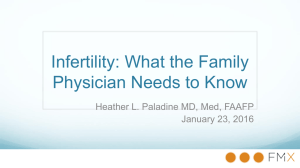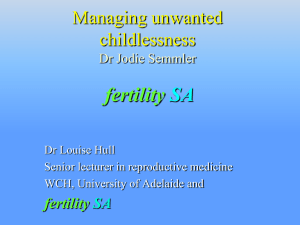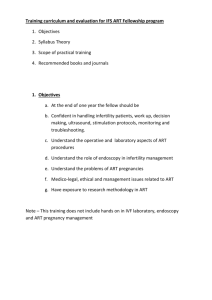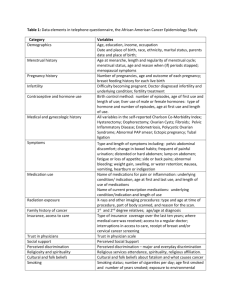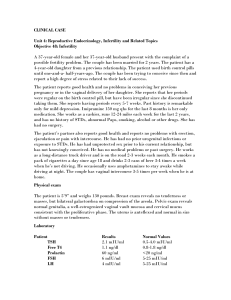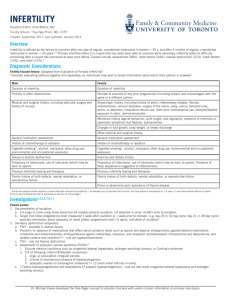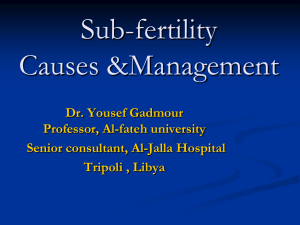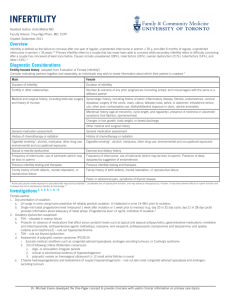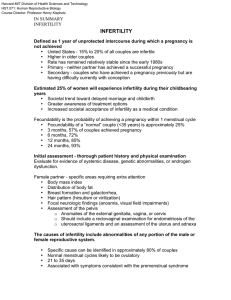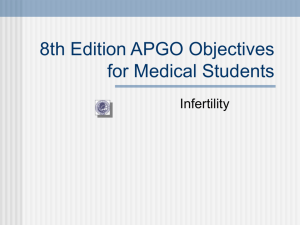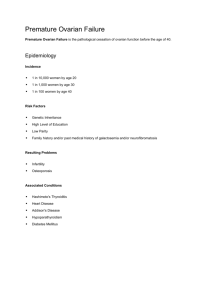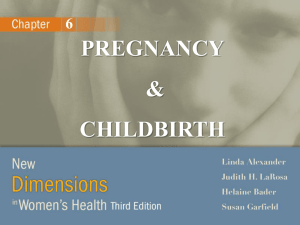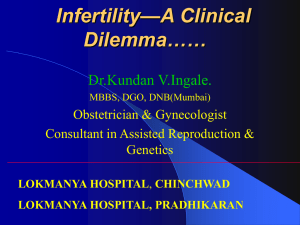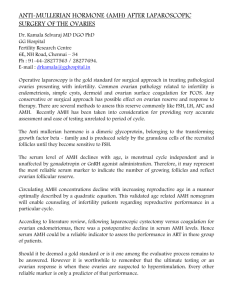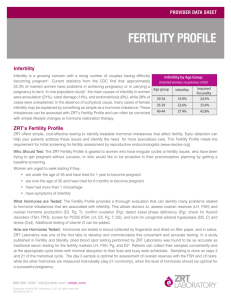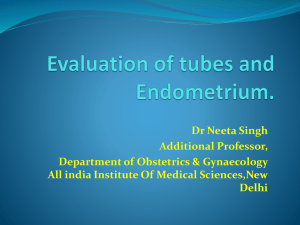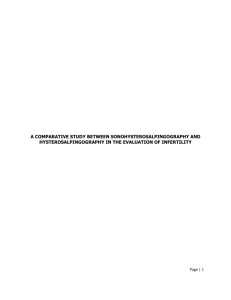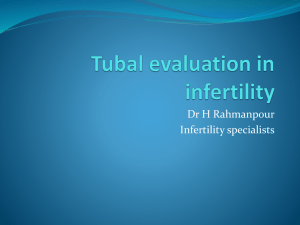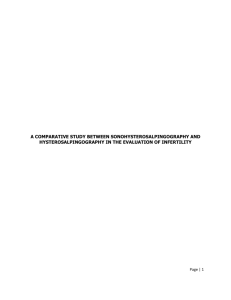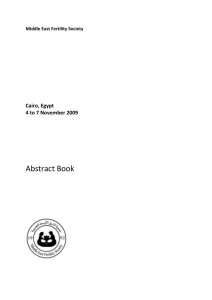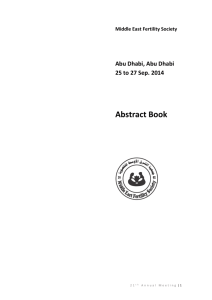Dr Ernest Hung Yu NG - Department of Obstetrics & Gynaecology
advertisement
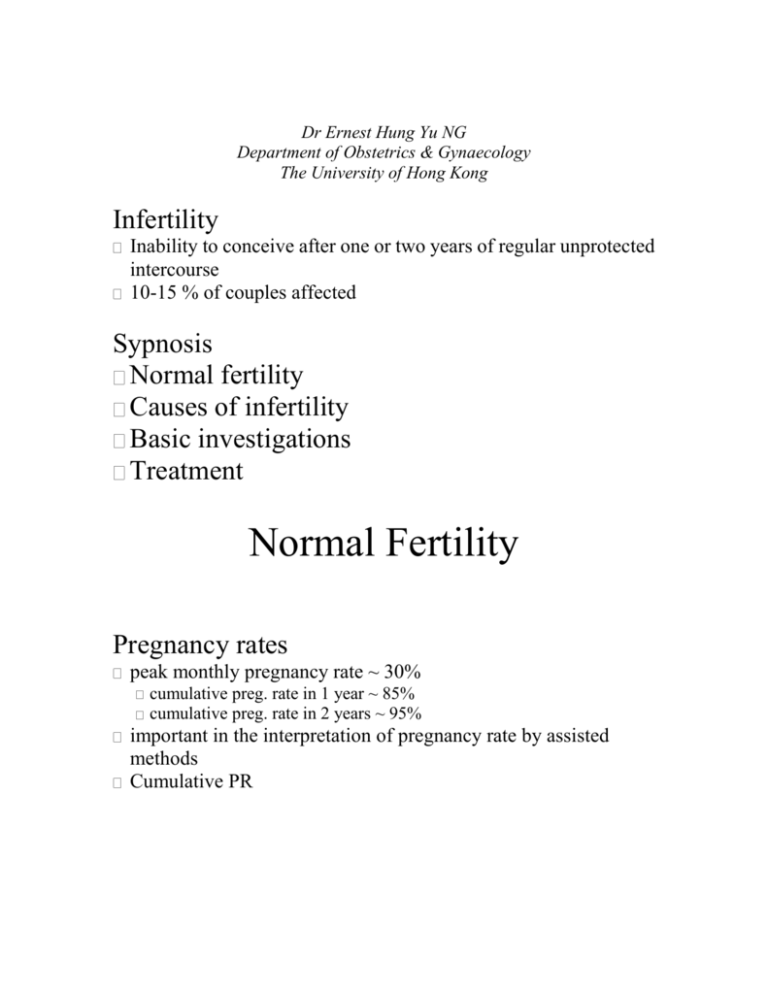
Dr Ernest Hung Yu NG Department of Obstetrics & Gynaecology The University of Hong Kong Infertility Inability to conceive after one or two years of regular unprotected intercourse 10-15 % of couples affected Sypnosis Normal fertility Causes of infertility Basic investigations Treatment Normal Fertility Pregnancy rates peak monthly pregnancy rate ~ 30% cumulative preg. rate in 1 year ~ 85% cumulative preg. rate in 2 years ~ 95% important in the interpretation of pregnancy rate by assisted methods Cumulative PR Causes of Infertility Causes of infertility Multiple factors are common Female factors (2/3) ovulatory (15%) tubal (20%) endometriosis (25%) others: cervical, immunological, coital Causes of infertility Male factors (1/3) subnormal semen due to production defects e.g. idiopathic, endocrine, trauma, genetic no sperm due to obstructive defects e.g. absent vas, vasectomy coital Unexplained ovulation, patent tubes and normal semen Three important causes Ovulatory dysfunction Tubal problems Male factors History Age Menstrual cycle regularity History of PID or pelvic surgery Previous investigations and treatment Age / occupation Past health Coital history Smoking/alcoholic Physical examination Body weight Vaginal examination uterine size mobility adnexal mass ? Necessary Testicular size Vas & epididymis Varicocele Early referral >35 years old Irregular cycles Previous pelvic surgery Previous STD Abnormal pelvic examination Basic Investigations Investigations-Basic semen analysis: 2 to 3 samples after 2-7 days of sexual abstinence WHO criteria: volume: >=2.0 ml concentration: >=20 million / ml motility: >=50% forward progression or >=25% rapid progression normal forms: ??? 20% at QMH Predictive values Sperm Functions Investigations-Ovulation Mid-luteal progesterone Irregular cycles FSH/LH, prolactin, thyroxine Ultrasound--ovarian morphology (PCO) Regular cycles prolactin or thyroxine not indicated Transvaginal scanning Investigations-Tubal patency Hysterosalpingogram Laparoscopydiagnostic / therapeutic Ultrasound examination Investigations Not indicated in routine practice: Serum antisperm antibody Postcoital test Sperm function test Endometrial biopsy Hysteroscopy USS of endometrium Treatment General advice (Female) 0.4 mg folic acid whilst trying to conceive and during the first 12 wks of pregnancy to prevent neural tube defects Reduce body weight in obese women Stop smoking Avoid excessive alcohol General advice (Male) Stop smoking Avoid excessive alcohol Men with poor quality sperm advised to wear loose fitting underwear and trousers and avoid occupational or social situations that might cause testicular hyperthermia Causes of infertility Ovulatory Tubal factors Male factors Unexplained/min. endometriosis Aim Development of a single follicle Ovulation induction Weight reduction Drugs Clomiphene citrate Gonadotrophin releasing hormone agonist--pulsatile manner via a pump Gonadotrophin Insulin sensitising agents (metformin) Surgery ovarian drilling Clomiphene citrate Started from day 5 for 5 days Dose: 50-250 mg daily for 6-9 months Ovulation: 60-80%; pregnancy rate: 30-40% Higher failure in obese women and those with greater ovarian volume on scanning SE: multiple pregnancy (10%); hot flushes, hair loss, visual change, ?ovarian cancer Clomiphene citrate Not indicated in patients with regular ovulations Not useful in improving pregnancy rates! Side-effects Anti-oestrogenic effects on cervical mucus / endometrium Long term risks e.g. risk of ovarian CA Problems in ovulation induction by gonadotrophin Unpredictable responses Exaggerated responses High risk of multiple pregnancy and ovarian hyperstimulation syndrome High risk of abortion Expensive: drugs, monitoring, preterm baby Causes of infertility Ovulatory Tubal factors Male factors Unexplained/min. endometriosis Tubal Factors Tubal surgery microsurgical technique laparotomy or laparoscopy adhesiolysis, re-anastomosis, salpingostomy results IVF/ET Tubal Surgery Vs IVF/ET The lesions The infertile couple The medical service Causes of infertility Ovulatory Tubal factors Male factors Unexplained / endometriosis Male Infertility Effective Treatments Vasectomy reversal/overcome correctable obstruction Gonadotrophins or GnRH for hypogonadotrophic hypogonadism Bromocriptine for sexual dysfunction associated with hyperprolactinaemia Male Infertility Varicocele treatment may improve semen quality and pregnancy rate in oligozoospermic men , but not in infertile men with normozoospermia Ovarian stimulation+insemination IVF/ET Male Infertility Ineffective Rx or Rx of Doubtful Value Anti-oestrogens, androgens, bromocriptine & kinin-enhancing drugs for abnormalities of semen quality Antioxidants, mast cell blockers & alpha blockers need further evaluation Systemic corticosteroids for antisperm antibodies Minimal/ mild endometriosis Medical treatment does not enhance fertility Surgical ablation (diathermy or laser) improves fertility in infertile women Ovarian stimulation+insemination IVF/ET Assisted Reproduction Procedure Density gradient centrifugation Superovulation & IUI--efficacy 932 women with ovulation and patent tubes up to 4 treatment cycles Treatment ICI IUI COH/ICI COH/IUI PR/patient (%) 23/233 (10) 42/234 (18) 44/234 (19) 77/231 (33) (Guzick et al., 1999) Factors affecting the outcome Ovarian stimulation regimens Clomiphene citrate (CC) hMG/FSH (gonadotrophins) CC + hMG/FSH GnRH agonist (long protocol) + hMG/FSH GnRH agonist (short protocol) + hMG/FSH GnRH agonist (ultrashort) + hMG/FSH Transvaginal ultrasound-guided oocyte retrieval (TUGOR) Intracytoplasmic sperm injection Sources of sperm for ICSI Preimplantation biopsy Unfertilized egg Polar body biopsy Cleavage stage embryo Blastomere biopsy Blastocyst (IVF or flushed) Trophectoderm biopsy Psychosocial care Explanation Counselling Support Psychosocial clinic at QMH
